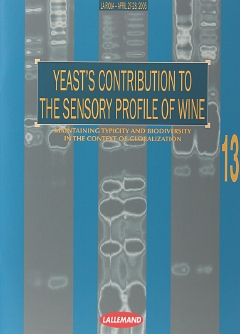Yeast's Contribution to the Sensory Profile Of Wine
| Auteur(s) auteurs | Colloque Lallemand N°13 - La Rioja - 2005 |
|---|---|
| Nb pages nb_pages | 72 |
| Année d'édition anneedition | 2005 |
| Langue(s) langues | N/A |
| Autres versions disponibles versions_disponibles | Aucune |
| Récompenses recompenses | Non |
| Franco France price | 35,00 € |
| Franco tous pays price_expo | 40,00 € |

FOREWORD
The role of yeast in winemaking is for much more than alcoholic fermentation. The impact of yeast on the sensory quality of wines became abundantly clear at the XVIIes Entretiens Scientifiques Lallemand held in La Rioja, Spain, on April 27 and 28, 2005. The technical meeting this year brought together researchers, winemakers and oenologists from eight countries to discuss advances in winemaking science and oenological practices related to the utilization of selected natural yeast in the production of wines. The nearly 200 attendees learned from the presentations and discussions on the sensory contribution of yeast, leading to a better understanding of its role in maintaining the typicity and biodiversity of wine in a context of globalization. Such issues as the sensory contribution of yeast, legislation regarding the use of yeast and its derivatives, research into genetically-modified microorganisms and their potential, and the ecology of yeast dissemination were covered in the scientific papers presented.
Attendees were then invited to a round table discussion with 10 oenologists and winernakers from Europe and the New World who shared their perspectives on the practical aspects of utilizing selected natural yeast. They were concerned most by two issues: maintaining the natural character and typicity of wines, and offering consumers wines of faultless quality.
Not only do these technical meetings help attendees stay informed, the scientific presentations, the experiences of the winemakers and oenologists, and the comments from participants expressed at the XVIIes Entretiens Scientifiques will help Lallemand direct yeast research, production and communications to better respond to the increasingly specific and distinctive needs of the users of selected natural yeast.
CONTENTS
- Selection and potential of australian Saccharomyces Bayanus yeast for increasing the diversity of red and white wine sensory properties
Jeffrey M. Eglinton, I. Leigh Francis and Paul A. Henschke - Creation of different vinification concepts using the geisenheim yeast finder
Grossmann, Manfred K., Reinhold Schaefer, Jens Bakoczy and Anja Abd Elrehim - The impact of yeasts on the varietal aroma of wine
Vincente Ferreira - Use of yeasts in burgundy and in other regions: fermentation and aging on lees
Michel Feuillat - Outlook of the OIV on the use of biological tools in wines
Santiago Minguez - Wine yeast strain development strategies: possibilities and limitations
Florian F. Bauer - Role of yeast in the hydrolysis of glycosidically bound volatile compounds during winemaking
Maurizio Ugliano, Alessandra Rinaldi, Angelita Gambuti, Luigi Moio, Eveline J. Bartowsky, Isak S. Pretorius and Paul A. Henschke - Selected yeast utilization and biodiversity
Eva Valero, Dorit Schuller, Brigitte Cambon, Margarida Casal and Sylvie Dequin - The potential of Saccharomyces cerevisiae wine yeast to improve red wine colour
Eveline J. Bartowsky, Simon J. Dillon, Paul A. Henschke, Andrew J. Markides, Ann Dumont, Anne Ortiz-Julien, Isak S. Pretorius and Markus Herderich - Round table discussion: the impact of selected natural yeast on wine style and marketability
Moderator: Joe Wadsack.
